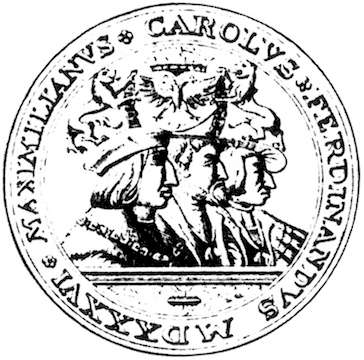effigies of Maximilian, Charles und Ferdinand, looking to the right and with order of the Golden Fleece.
On their hats: Two lions hold the crowned imperial shield and the collar.
For Halačka, this medal is the oldest model for the following "three-emperors strikes".
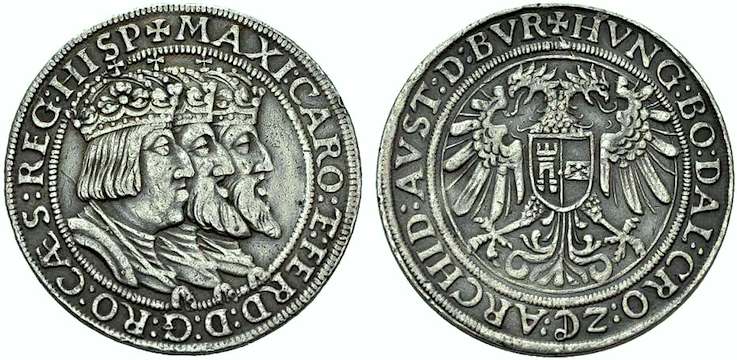 1/2 "three-emperors thaler" n. d., Hall. Ø 35 mm. thaler: M./T.165; Voglh.45; Dav.8053.
1/2 "three-emperors thaler" n. d., Hall. Ø 35 mm. thaler: M./T.165; Voglh.45; Dav.8053.
Obv.: + MAXI:CARO:(ET):FERD:D:G:RO:CÆS:REG:HISP
(ET) ligated
crowned busts stagged to the right, each carrying the Golden Fleece on a ribbon; Maximilian beardless.
Rev.: + HVNG:BO:DAL:CRO·ZC·ARCHID:AVST:D:BVR
Double eagle with shield (Castile/Austria) on the breast.
The previous obvers with the effigies of the three emperors was also struck in combination
with two other revers designs.
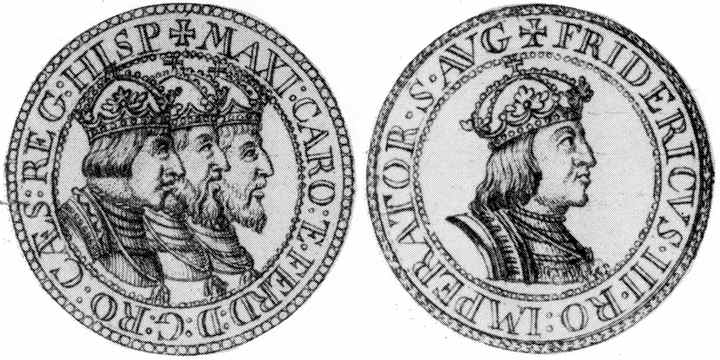 Three-emperors thaler n. d., Hall. Ø 35 mm, 33,6 g. M./T.-; Voglh.46; Dav.8054.
Three-emperors thaler n. d., Hall. Ø 35 mm, 33,6 g. M./T.-; Voglh.46; Dav.8054.
Obv.: as bevor
Rev.:+ FRIDERICVS·III·RO:IMPRRATOR·S·AVG
Armored bust of emperor Frederick III with crown and orden, quite matching the busts of the obvers.
The combination of the above "Dreikaiser side" with the following coat of arms is probably from the time of Archduke Ferdinand, the 2nd son of Emperor Ferdinand I.
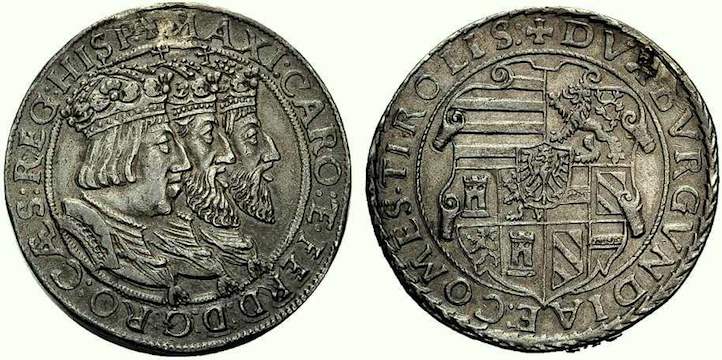 Three-emperors thaler n. d., Hall. Ø 35 mm, ca.33 g. M./T.165a; Voglh.85; Dav.8103.
Three-emperors thaler n. d., Hall. Ø 35 mm, ca.33 g. M./T.165a; Voglh.85; Dav.8103.
Obv.:
as bevor.
Rev.:+ DVX·BVRGVNDIAE:COMES·TIROLIS:
Quartered shield: Old Hungary, Bohemia, Castile/Leon, Austria/Burgundy.
Over all: Tirolian eagle.All these three strikes from Hall show the same obvers and the typical "+" at the beginning of the legends.
3. Strikes from Bohemia
3a With date "90", the effigies look to the left (Halačka: typ 1)
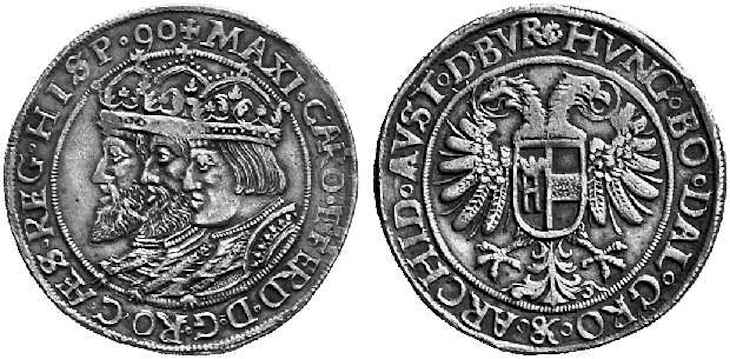 "three-emperors strike" 1590, Joachimstal (?) Ø 41 mm, 29,14 g.
"three-emperors strike" 1590, Joachimstal (?) Ø 41 mm, 29,14 g.
Diet.-; Halacka 387a; Voglh.86(Hall); Dav.8105(Hall).
Obv.: +MAXI
milianus·CARO
lus·E
t·FERD
inandus·D
ei·G
ratia·RO
manorum·CAES
ares·REG
es·HISP
aniae·90
Crowned bust of Maximilian (beardless), Charles V and Ferdinand I in tandem arrangement
and each with the order of the Golden Fleece on a ribbon.
Rev.: ¤HVNG
ariae◦BO
hemiae◦DAL
matiae◦CRO
atiae◦&◦ARCHID
uces◦AVST
riae◦D
uces·BVR
gundiae
Double eagle with head halo and breast shield (Castile/Austria).
This type ist known as ½, 1, 1½, 2, 3, 4 thaler. Also, gold pieces were struck in the weight of 5, 10 and 20 ducats.
This commemorative strike was minted in 1590 during the reign of emperor Rudolph II. No minting sovereign is mentioned in the legend and the occasion for the coinage is unknown. It is also unclear where these pieces were minted, but they are certainly not from Hall, as the mint used only rolling mills at the time in question. Halacka (1987) indicates Joachimstal as mint and Paul Hofmann as mintmaster, but Prague could also be the mint of this strike.
|
3b not dated, effigies looking to the right (Halačka: typ 2)
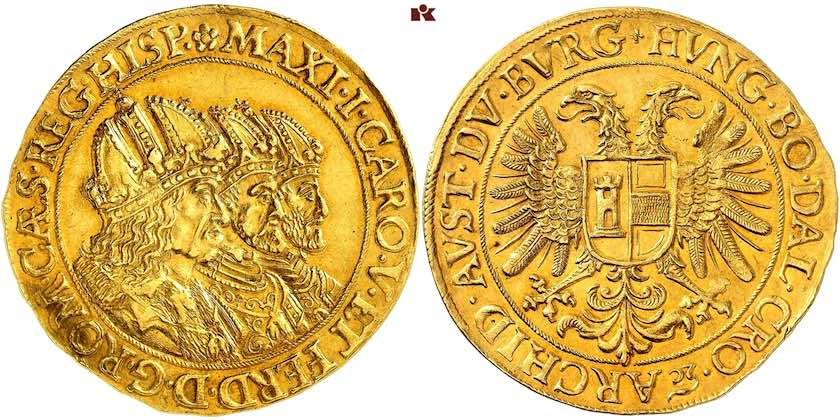 5 ducats n.d., off-metal strike of a "three-emperors strike", Prague.
5 ducats n.d., off-metal strike of a "three-emperors strike", Prague.
Ø 41 mm, 17,35 g. Diet.552; Friedb.111; Voglh.120/2 (in silver); Dav.3066 (in silver).
A commemorative strike from the reign of emperor Rudolph II, again without a minting sovereign's title. The design is similar to the former piece, but the emperors here look to the right, and their crowns now carry mitres in the style of Rudolph's new crown.
Obv.: ❀MAXI·I·CARO·V·ET FERD·D·G·ROM·CÆS·REG·HISP.
Rev.: +HVNG·BO·DAL·CRO·zc ARCHID·AVST·DV·BVRG
|
This type is known in silver (weight of 1, 1½, 2, 3 thalers) and in gold (weight of 5, 10 und 15 ducats). Halačka (1992) uses the name "three-emperors strike" and avoids the term "thaler".
Halačka (1992) considers the mint in Prague the most likely place of orgin for these splendid strikes:
In 1590, the die cutter Zacharias Kempf left the Joachimstal mint for reasons of health. He was allowed a pension of 15 "Weissgroschen" a week. When Kempf asked emperor Rudolf II for a raise, he sent a pair of dies for these strikes with his petition. As emperor Rudolf II stayed in Prague during his entire reign, it is most likely that the dies were taken to the mint there. Besides, in the 1590s, only the mint in Prague stuck thalers as well as gold pieces in Bohemia.
|
3c not dated, with effigy and title of emperor Matthias (Halačka: typ 3)
For the first time, the mint sovereign is indicated on a "Three-Emperors-Thaler".
The "Three-Emperors" here appear on the reverse of a strike showing the effigy and titles of emperor Matthias on the obverse.
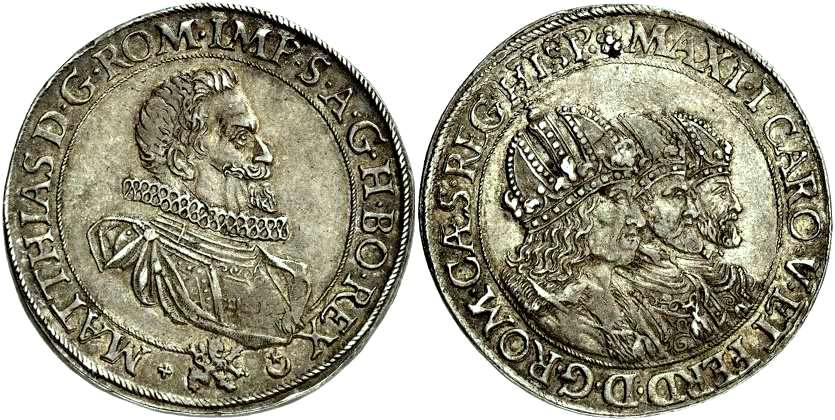
Thaler, no year indicated, Prague. Ø 41mm,
Voglh.120/1; Diet.521; Halacka 493; Dav.3064.
Obv.: + MATTHIAS Dei·Gratia·ROManorum·IMPerator·Semper·Augustus·Germanie·Hungarie·BOhemie·REX
Matthias's effigy, looking to the right, with beard, decorative cuirass, millstone collar and
necklace of the Order of the Golden Fleece.
Mintmarks at the bottom: crowned Bohemian lion and moon with star.
Rev.: ¤ MAXI·I·CARO·V·ET FERD·D·G·ROM·CÆS·REG·HISP Legend and picture as before.
This type is known as thaler, 1½-, 2-, 3- and 4-thaler.
Because of the inscription "Romanorum Imperator" on the obverse, this strike can be dated to the years between 1612 and 1619. The commemorative was ordered for June 24, 1612, when Matthias was elected and crowned Roman Emperor. The effigy on the obverse was used for the thaler coinage in Kuttenberg from 1613 to 1617 (Voglh.115/2).
|
Ref.:
• Halačka, Ivo: Die sog. "Dreikaiser-Prägungen" aus den böhmischen Münzstätten,
in Haller Münz Blätter, vol.V, p.323-8 (1992)
• Mince zemí Koruny Ceské 1526-1856 [The coins of the Bohemian crown-lands], vol.1: 1526-1620. (1987)
• Moser, H. / Tursky, H. (M./T.): Die Münzstätte Hall in Tirol 1477-1665. Innsbruck 1977.
• Voglhuber, R.: Taler und Schautaler des Erzhauses Habsburg. Frankfort 1971.
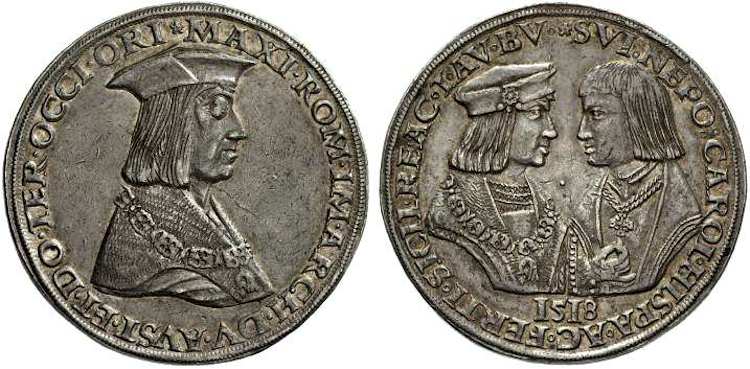
 start page
start page
